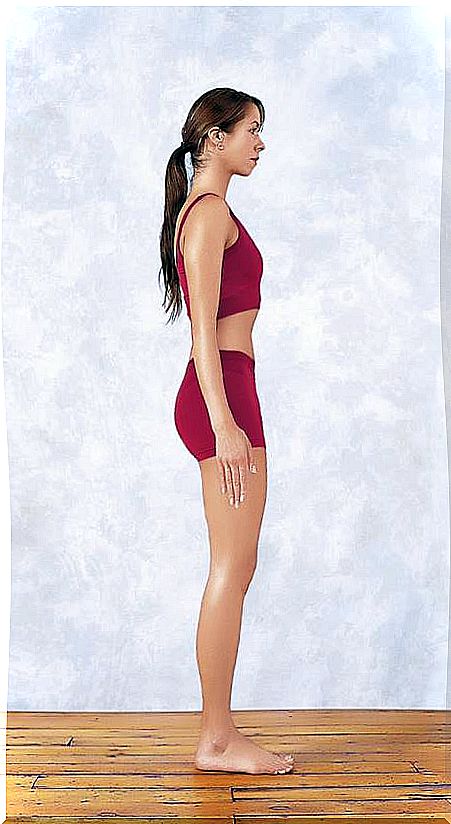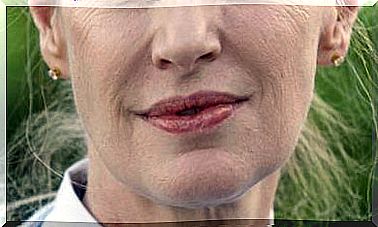Learn To Properly Align Your Back
Good posture that keeps the spine aligned frees muscles and joints from overload. We explain how to get it.

A body is well aligned when the head, trunk, and pelvis follow an imaginary vertical line that begins at the feet and exits the crown. When this occurs, very little muscle activity is required to maintain posture and the joints are not overloaded.
The balance is easy and the body sensation is lighter. Internalizing correct alignment is just as important as strengthening the muscles that contribute to it. This alignment can be described in more detail:
- The abdomen is pulled back towards the spine to keep the pelvis aligned.
- The rib cage does not protrude from the front.
- The neck remains elongated, with the cervicals extended and the chin closer to the chest than prominent.
How to properly align your back step by step
To achieve this pose, stand in profile in front of a mirror. Imagine that a vertical line (you can use the edge of the mirror to draw it) joins the following points:
- The earlobe
- The shoulder
- The center of the rib cage
- The head of the femur
- Knee
- Ankle
What’s more:
- The feet must be kept in a neutral position (neither inside nor outside).
- The knees are straight but not hyperextended back.
- The pelvis, in a neutral position (without taking it forward or backward).
- The spine retains its normal curves (not reduced or increased).
- Scapulae in neutral position.
- The shoulders are open (not forward) and the head on the shoulders (not forward).
Little by little, with the repeated activation of the muscles that allow to maintain this posture, the body begins to automatically use them to organize itself in a more effective way.
How to take care of the spine
Alignment problems often come from an exaggerated curvature of the spine in some of its sections. It can be an excessive cervical curve (cervical lordosis) that leads to advance the head in front of the shoulders.
Or an increase in the curve in the thoracic region (kyphosis), common with aging and that in the initial stages can be tried to correct by exercising the upper extensor muscles of the spine.
If the increase in curvature occurs in the lumbar region ( lumbar lordosis and hyperlordosis), generally accompanied by a pelvis tilted forward, it can be tried to correct by strengthening the abdominals and making the lower spinal extensors and the iliopsoas muscle more flexible.
However, keep in mind that alignment problems can have many causes and that it may be necessary to visit a professional before taking initiatives that may not be appropriate.
Once the alignment of the body in the upright position is improved, it is easier to maintain it in any other position or in motion as well.
Be careful how you feel
A common misalignment when sitting is letting the spine sag, flexing the lower back and pulling the pelvis back.
Consider raising your upper back and head area just behind the ears toward the ceiling , with the weight of the trunk on the sit bones.
Another helpful strategy is to think about picking up and slightly raising your lower abdominal region.
Posture for good bone alignment
The idea is widespread that you have to maintain a disciplined program of physical exercise to enjoy good muscle tone and that you have to do constant stretching to relieve accumulated tension in the muscles.
But strength and flexibility come naturally when you live respecting the structure of the body, with well-aligned bones, relaxed muscles, and free joints.
Our musculoskeletal system works like a system of pulleys (muscles), levers (bones), and hinges (joints), which might be reminiscent of a crane.
We often tend to think that muscles do the job of supporting all body weight. This is only partly true, because when the bones are in their proper place, they sustain us with little work.
Good posture prevents excessive muscle tension
The primary function of the muscles is to move the bones. However, at rest, when the bones are misaligned, the muscles are forced to tighten to compensate for skeletal deviations.
A healthy muscle is elastic, capable of contracting when called upon but also able to relax when its action is not needed. Overdeveloped muscles store too much tension, they never fully relax.
Maintaining a relaxed posture does not mean slumping down or spreading out. Rather, the bones have to be aligned so that the muscles can relax.
Releasing the joints: more flexibility and less pain
True flexibility is also achieved when the joints are released, not through indiscriminate stretching of certain muscles.
By learning to respect the natural bone alignment, the muscles gradually return to their natural extension and elasticity.
When the joints that bear the most weight (ankles, knees, hips, shoulders) are aligned with a central axis, the person usually does not suffer pain or tension.









